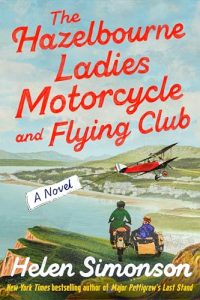Helen Simonson’s latest novel, The Hazelbourne Ladies Motorcycle and Flying Club, is set in a fictional British seaside town, in the immediate aftermath of World War I. Its main protagonist is Constance Haverhill, a capable young woman of modest means, who spent the war years managing the estate of her mother’s childhood friend, Lady Mercer. Now that war is over and men are returning, Lady Mercer has informed Constance her services are no longer needed; also, Constance will need to move out of the cottage she’s been living in to make room for the new estate manager’s family. As a temporary courtesy, Constance has been asked to accompany Lady Mercer’s mother, Mrs. Fog, on holiday, but once this interlude is over she will be out of a job and a place to live.
Given its setting and subject matter, this could have been a much grittier book. There are oblique references to the population’s overall gauntness, mentions of crippled soldiers begging for alms at London railroad stations, and multiple accounts of family members lost to influenza. Instead, Simonson ensconces her characters in the charming resort community, Hazelbourne-on-Sea, and directs them in what book publicity material calls “a timeless comedy of manners.”
To pull off this production, Simonson enlists an extensive cast of supporting characters, representing many ranks of British society. There’s Constance’s new friend, Poppy Wirrall, the trouser-wearing daughter of a local baronet, who runs the titular motorcycle club in collaboration with women she served with as a dispatch rider during the war. (She’s also organized Wirrall’s Conveyance, a motorcycle taxi and delivery service to provide employment for less well-off members of the club.) There’s Poppy’s brother Harris, a morose former Royal Flying Corps pilot who lost a leg in battle, and Jock Macintyre, his mechanic, who survived the war but turns to drink upon losing his wife and daughters to influenza. There is Kumar Pendra, an RFC pilot from British India, who notes to Constance that service members from countries with dominion status (“the Anzacs, the South Africans, and even the Chinese Labor Corp…”) receive more favorable post-war treatment than those from colonies like his, which are agitating for home rule. And there is Percival Allerton, a wealthy American engaged to Lady Mercer’s daughter, Rachel, who is concerned Mrs. Fog’s renewed friendship with the de Champney siblings, rumored to be “of mixed bloodline” even though they are the children and acknowledged heirs of a prominent Barbados sugar planter, will damage his family’s reputation.
Together, through clever dialogue and revealing interactions, these characters—some wittingly, others unwittingly—bring to life the social and familial upheaval caused by war and epidemic. You have an old guard adamantly attempting to restore pre-war hierarchies of race, gender, and class; emotionally and physically damaged soldiers whose status as landed gentry no longer guarantees them employment, fiancées, or respect; families decimated by influenza; and women who embraced new jobs and freedoms during the war, only to be laid off and sent home now it’s over.
As expected, characters mostly allude to their consciousness of these rifts and inequities indirectly, through droll and circumspect dialogue. Nevertheless, it is clear who is embracing change, who isn’t, and what some of the collateral damage will be. This book is recommended to readers who appreciate a British sensibility, historical fiction without too much grit, and social commentary in the tradition of Jane Austen.
Simonson, Helen. The Hazelbourne Ladies Motorcycle and Flying Club: A Novel. The Dial Press, 2024.


